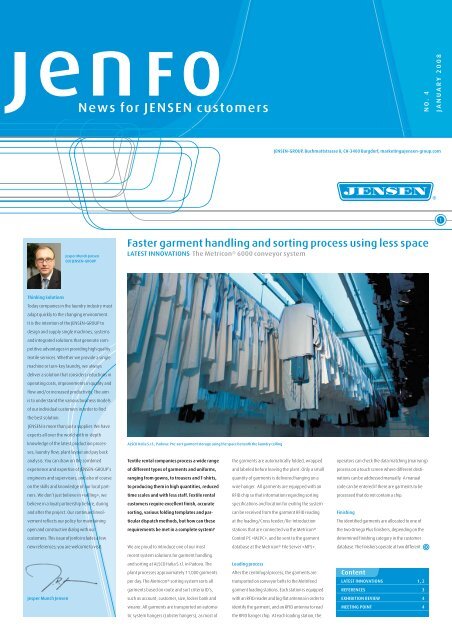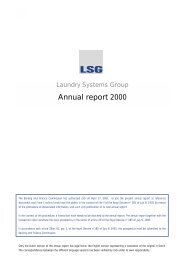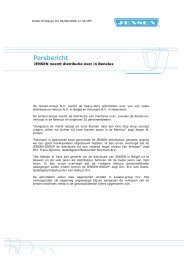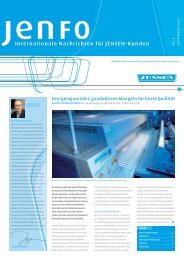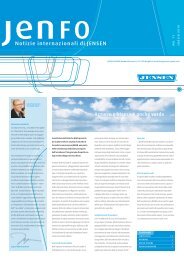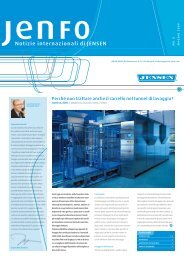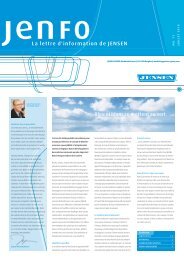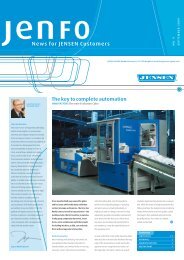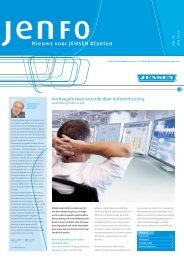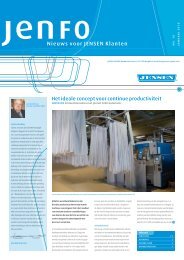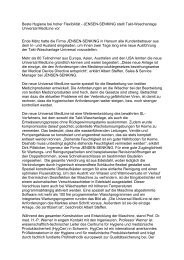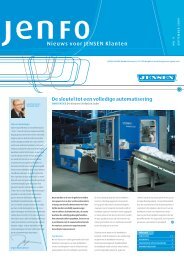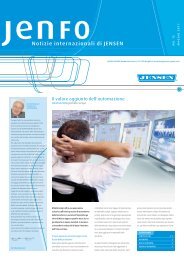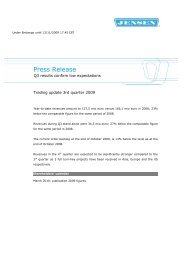News for JENSEN customers - Jensen Group
News for JENSEN customers - Jensen Group
News for JENSEN customers - Jensen Group
Create successful ePaper yourself
Turn your PDF publications into a flip-book with our unique Google optimized e-Paper software.
<strong>News</strong> <strong>for</strong> <strong>JENSEN</strong> <strong>customers</strong><br />
Jesper Munch <strong>Jensen</strong><br />
CEO <strong>JENSEN</strong>-GROUP<br />
thinking Solutions<br />
Today companies in the laundry industry must<br />
adapt quickly to the changing en vironment.<br />
It is the intention of the <strong>JENSEN</strong>-GROUP to<br />
design and supply single machines, systems<br />
and integrated solutions that generate competitive<br />
advantages in providing high quality<br />
textile services. Whether we provide a single<br />
machine or turn-key laundry, we always<br />
deliver a solution that considers reductions in<br />
operating costs, improvements in quality and<br />
flow and/or increased productivity. The aim<br />
is to understand the various business models<br />
of our individual <strong>customers</strong> in order to find<br />
the best solution.<br />
<strong>JENSEN</strong> is more than just a supplier. We have<br />
experts all over the world with in-depth<br />
knowledge of the latest production processes,<br />
laundry flow, plant layout and pay back<br />
analysis. You can draw on the combined<br />
experience and expertise of <strong>JENSEN</strong>-GROUP’s<br />
engineers and supervisors, and also of course<br />
on the skills and knowledge of our local partners.<br />
We don’t just believe in «selling», we<br />
believe in a loyal partnership be<strong>for</strong>e, during<br />
and after the project. Our continued in vol-<br />
vement reflects our policy <strong>for</strong> maintaining<br />
open and constructive dialog with our<br />
<strong>customers</strong>. This issue of Jenfo includes a few<br />
new references; you are welcome to visit.<br />
Jesper Munch <strong>Jensen</strong><br />
textile rental companies process a wide range<br />
of different types of garments and uni<strong>for</strong>ms,<br />
ranging from gowns, to trousers and t-shirts,<br />
to producing them in high quantities, reduced<br />
time scales and with less staff. textile rental<br />
<strong>customers</strong> require excellent finish, accurate<br />
sorting, various folding templates and particular<br />
dispatch methods, but how can these<br />
requirements be met in a complete system?<br />
We are proud to introduce one of our most<br />
recent system solutions <strong>for</strong> garment handling<br />
and sorting at ALSCO Italia S.r.l. in Padova. The<br />
plant processes approximately 11,000 garments<br />
per day. The Metricon ® sorting system sorts all<br />
garments based on route and sort criteria ID’s,<br />
such as account, customer, size, locker bank and<br />
wearer. All garments are transported on automatic<br />
system hangers (Lobster hangers), as most of<br />
N O. 4<br />
<strong>JENSEN</strong>-GROUP, Buchmattstrasse 8, CH-3400 Burgdorf, marketing@jensen-group.com<br />
Faster garment handling and sorting process using less space<br />
LatESt INNOvatIONS the Metricon ® 6000 conveyor system<br />
Die Enthüllung der UNIvERSaL HighLine<br />
aLSCO Italia S.r.l., Padova: Pre-sort garment storage using the space beneath the laundry ceiling<br />
the garments are automatically folded, wrapped<br />
and labeled be<strong>for</strong>e leaving the plant. Only a small<br />
quantity of garments is delivered hanging on a<br />
wire hanger. All garments are equipped with an<br />
RFID chip so that in<strong>for</strong>mation regarding sorting<br />
specifications and location <strong>for</strong> exiting the system<br />
can be received from the garment RFID reading<br />
at the loading/Cross feeder/Re-Introduction<br />
sta tions that are connected via the Metricon ®<br />
Control PC «MCPC», and be sent to the garment<br />
database at the Metricon ® File Server «MFS».<br />
Loading process<br />
After the centrifugal process, the garments are<br />
transported on conveyor belts to the Metrifeed<br />
garment loading stations. Each station is equipped<br />
with an RFID reader and big flat antenna in order to<br />
identify the garment, and an RFID antenna to read<br />
the RFID hanger chip. At each loading station, the<br />
operators can check the data matching (marrying)<br />
process on a touch screen where different destinations<br />
can be addressed manually. A manual<br />
code can be entered if there are garments to be<br />
processed that do not contain a chip.<br />
Finishing<br />
The identified garments are allocated to one of<br />
the two Omega Plus finishers, depending on the<br />
determined finishing category in the customer<br />
data base. The finishers operate at two different<br />
Content<br />
LatESt INNOvatIONS 1, 2<br />
REFERENCES 3<br />
ExHIBItION REvIEw 4<br />
MEEtING POINt 4<br />
JaNUaRy 2008<br />
1
2<br />
temperatures on the upper floor, in order to save<br />
as much ground floor space as possible. Garments<br />
with special finishing requirements are<br />
transported directly to the «press» area via a bag<br />
system. After the garments have been pressed,<br />
the operator puts the hanger on the «pick up»<br />
conveyor, which automatically transports the<br />
hanger to the automatic marrying station. The<br />
RFID in the garments and the RFID on the Lobster<br />
are automatically read. The in<strong>for</strong>mation about the<br />
garment is matched up in the hanger database<br />
from this position.<br />
Inspection and repair<br />
All finished garments must be sent to the four<br />
inspection stations to be passed. The stations<br />
have an automatic and manual mode, each with<br />
visual inspection and re-addressing possibilities<br />
on the touch-screen, such as repair, rewash,<br />
exchange, no read, stock and A-Sort.<br />
Pre-sort buffer<br />
Be<strong>for</strong>e sorting, the garments are allocated into<br />
Pre-Sort (A-sort), according to the following<br />
criteria:<br />
1. The same route is found<br />
2. An empty rail is found<br />
3. The rail with the least amount of garments<br />
is found<br />
Up to 40 Lobster hangers can be stored per meter<br />
on the Metristore in A-Sort. When A-Sort clearly<br />
reaches its capacity, feeding into the A-Sort is<br />
automatically stopped. A configurable amount of<br />
garment-free space must be set up to allow<br />
re-circulating garments to re-enter A-Sort.<br />
automated marrying station<br />
Recirculation sorting system<br />
The Recirculation sorting principle was the most<br />
appropriate of the four existing types of sorting<br />
systems, due to space-saving reasons, as well<br />
as productivity and versatility. Different solutions<br />
have been requested, including processing<br />
significant portions of individual garments and<br />
garments only sorted by article and size. The<br />
Recirculation sorting system has a sorting<br />
capacity of up to 2000 garments per hour.<br />
A special buffer with a capacity of 1000 garments<br />
has been set up between the Pre-sort and Final-<br />
Sort in order to increase the sorting capacity.<br />
As soon as a route enters the final sorting stage,<br />
the next route stored in the special buffer can<br />
then directly enter Final-sort. Thus, time is saved<br />
with regards to discharging a route that can be<br />
split up over 2-3 rails in the Pre-sort and transporting<br />
it to the Final-sort, as sorting can con tinue<br />
immediately.<br />
automated de-loading and folding<br />
Directly after sorting, a complete route is dispatched<br />
to one of the three fully automatic<br />
garment folders, Maximat Industrial, thus it is<br />
significant to maintain route integrity. The routes<br />
are automatically allocated to the three folding<br />
machines after sorting, depending on their classification,<br />
or are manually allocated by the operator.<br />
Folding template/program and stack change<br />
in<strong>for</strong>mation is sent directly to the folder via the<br />
hanger chip. Maximat Industrial automatically<br />
carries out full hanger de-loading, garment feeding,<br />
folding and stacking. Directly after folding,<br />
a sticker is printed and placed on each stack.<br />
The empty Lobster hangers are returned on an<br />
express rail to the Metrifeed stations as quickly<br />
as possible.<br />
Re-hanging station<br />
Garments requiring hanging delivery are sent<br />
directly from sorting to the re-hanging station.<br />
Here the Lobster hanger is fixed by an Easy-Load<br />
un-loading station at the exit, where the garment<br />
is then taken off to be re-hung on a wire hanger<br />
with a Metrifeed station.<br />
Display of garment system on MFS computer and handheld device<br />
Empty hanger return<br />
Empty hanger return<br />
Metrifeed<br />
Finisher 1<br />
Press<br />
Finisher 2<br />
Inspection<br />
station<br />
Pre-sort<br />
Recirculation<br />
Sort<br />
Metricon Live<br />
The supervisors at the Alsco plant use the Metricon<br />
Live application on a handheld device and on<br />
the MFS computer at the central desk. It displays<br />
the entire Garment finishing system, including<br />
alarms and real-time production statistics. Quick<br />
trouble-shooting is possible from anywhere in<br />
the laundry. Full mobility allows the operator to<br />
take immediate action.<br />
Press<br />
Cross feeder<br />
station<br />
Bypass<br />
Recirculation<br />
Recirculation<br />
Re-introduction<br />
Destinations:<br />
Repair, Rewash<br />
Exchange, Stock<br />
Maximat 1 Maximat 2 Maximat 3 Hanging delivery<br />
Re-hangingstation
N O. 4<br />
JaNUaRy 2008<br />
La Blanchisserie Centrale yverdon, Switzerland: Fully automated, space-saving laundry process in the washroom area<br />
High-quality textile service <strong>for</strong> Swiss hotel business<br />
REFERENCES La Blanchisserie Centrale yverdon, Switzerland<br />
In close co-operation with Mr. Kratzer, Managing<br />
Director of La Blanchisserie Centrale<br />
yverdon and laundry in Sierre and Mr. Schwab<br />
from Bardusch, <strong>JENSEN</strong> has developed a complete<br />
laundry solution to fit the new building.<br />
Mr. Carl Bardusch, who is majority shareholder<br />
of La Blanchisserie Centrale, personally<br />
decided to go ahead with the huge project<br />
with <strong>JENSEN</strong>-GROUP in December 2006. Six<br />
months later, the new automated laundry<br />
was fully operating in production.<br />
La Blanchisserie Centrale Yverdon specializes in<br />
the hospitality sector. The company provides a<br />
high-quality textile service <strong>for</strong> four and five star<br />
hotels in Switzerland. Personalized and pool hotel<br />
linen are processed together. At the entrance to<br />
the delivery area, all dirty linen is sorted into different<br />
categories, such as customer or finishing<br />
category and the washing program, with the<br />
Futurail Tri-Sort system. The dirty linen is thereby<br />
filled into hanging bags, which are stored on<br />
various rails in the Futurail Classified system just<br />
beneath the laundry ceiling. Thus the laundry<br />
entrance area is cleaned up quickly and kept<br />
free <strong>for</strong> incoming carts with dirty linen.<br />
Approximately 2.5 tons of hotel linen is processed<br />
at La Blanchisserie Centrale Yverdon every hour.<br />
Two washing tunnels, Senking Universal are con-<br />
tinuously loaded with 72 kg batches which are<br />
automatically fed from the bag storage system<br />
beneath the laundry ceiling. The two washing<br />
tunnels are able to operate with minimum<br />
water and energy consumption due to the dirty<br />
linen sorting process, well-planned washing<br />
process and integrated heat-recovery and waterrecycling<br />
system. After removing the water from<br />
the washed linen in two high-pressure presses,<br />
Senking SEP 72 HD (51 bar), the linen is raised by<br />
3.5m to a mezzanine with two lift-conveyors, one<br />
per washing line. At this height, there are 16 gasdryers<br />
Senking DT 90 installed on one line, which<br />
crosses the building along the laundry ceiling.<br />
This position saves space on the laundry floor<br />
and reduces the cost of exhaust ducting <strong>for</strong> each<br />
dryer. In addition, working conditions have also<br />
been improved, as the vacuum of fresh air <strong>for</strong><br />
the dryers no longer causes a draught on ground<br />
level. The linen batches from both washing tunnels<br />
are transported using a shuttle, which automatically<br />
takes the batches to the next free dryer.<br />
The dried linen is discharged on the other side<br />
of the dryer line onto four conveyor belts, also at<br />
3.5m. The belts <strong>for</strong>ward the linen batches to two<br />
loading stations where the batches then drop into<br />
a bag. The full bag is automatically transported on a<br />
rail system to the determined finishing destination.<br />
The bags containing fully dried towels are sent<br />
directly to the folding station, which consists of<br />
six Tematic Pro towel folders. Bed linen and duvet<br />
covers are routed to the ironer lines designed <strong>for</strong><br />
large pieces. The bags are directly discharged into<br />
the Viking 2000 separators that prepare the linen<br />
<strong>for</strong> fast and ergonomic feeding into the versatile<br />
feeder Logic Plus. A 3-roll EXPress ironer with<br />
flexible chest and an Universal folder at the back,<br />
ensures fast processing and high-quality finish.<br />
Small pieces are sent to the finishing line, which<br />
contains the Basic-I feeder, EXPress ironer with<br />
Fully automated transfer of clean linen to finishing stations<br />
flexible chest, and the Magic + Napkin-Bottomup<br />
folder. Table cloths are sent directly to the<br />
ironer line, with Variant 2000 at the front <strong>for</strong> the<br />
smooth and high-quality feed of delicate pieces.<br />
The entire laundry process is flexible. All finishing<br />
stations can be reached from every dryer. Bags<br />
containing clean linen can be stored at each<br />
finishing station to ensure a continuous process<br />
flow. The final destination of each linen batch in<br />
the Finishing area has already been determined<br />
at the dirty linen sorting station.<br />
3
4<br />
<strong>JENSEN</strong>-GROUP<br />
Marketing<br />
Buchmattstrasse 8<br />
CH-3400 Burgdorf<br />
www.jensen-group.com<br />
High interest in latest <strong>JENSEN</strong> developments at texcare asia ’07<br />
ExHIBItION REvIEw texcare asia in Shanghai, September 19–21, 2007<br />
the magnificent city of Shanghai Chinese laundry visit at Chanzhou ai xin Laundry Co. Ltd.<br />
<strong>JENSEN</strong>-GROUP has been sparking interest from<br />
numerous visitors with the most significant<br />
<strong>JENSEN</strong> equipment currently on the market.<br />
The live demonstration of the brand new Maximat<br />
Bathrobe Folder was of particular interest. This<br />
was sold to a Chinese laundry owner on the first<br />
exhibition day. The new Maximat is the unique<br />
combination of a towel and garment folder with<br />
fully integrated sorting options. On the third<br />
ex hibition day, Chinese <strong>customers</strong> and potential<br />
buyers were taken to visit one of the recent installations<br />
of <strong>JENSEN</strong> equipment at a private textile<br />
rental laundry outside Shanghai. It was amazing<br />
to see how fast the European state-of-the-art<br />
laundry system had been adapted and professionally<br />
used by the Chinese laundry managers.<br />
Development of the Chinese Market<br />
<strong>JENSEN</strong> set up its own Sales and Service Center in<br />
Shanghai, working with well-trained local per-<br />
sonnel in order to become closer to the emerging<br />
market. The office in Singapore has now<br />
become the Regional Headquarter, handling all<br />
Sales and Service matters in the region, supported<br />
by distributors and their own <strong>JENSEN</strong> companies<br />
in China and Australia. Initially the center<br />
acted as a support <strong>for</strong> individual machines,<br />
which are still being sold, but with the rapid<br />
development of the market, and the complexity<br />
of projects today, the design and project department<br />
at the Headquarters in Singapore has<br />
become increasingly significant.<br />
Those who believe the Chinese market is not<br />
developing are very wrong; today the Chinese<br />
market is swiftly becoming more sophisticated.<br />
For serious laundry operators, China is no longer<br />
just an initial investment. This is particularly<br />
small in comparison to the cost of long-term<br />
operation. We are seeing professional operations<br />
switch very quickly from using washer extractors<br />
to implementing CBW systems in order to save<br />
and preserve water, as well as switching to the<br />
most advanced CBW systems where the traditional<br />
Counter flow systems have been abandoned.<br />
Clearly the equipment must be high-quality here,<br />
however it must also work in synergy to support<br />
the increasingly significant usage of natural<br />
resources such as water and energy, which are<br />
constantly decreasing.<br />
The majority of capital in China is located in the<br />
cities, which is where the people want to live.<br />
It is a challenge <strong>for</strong> the Chinese government to<br />
supply such huge cities with energy and water.<br />
Electrical power is mainly produced in power<br />
plants operated with coal. The CO2 emissions<br />
cause acid rain, which affects natural resources.<br />
China must control its environmental pollution.<br />
Operations consuming high quantities of resources,<br />
such as laundries, will need to invest in<br />
water and energy saving equipment.<br />
Kaj andersn, <strong>JENSEN</strong> asia, tang Gui Fang, Chanzhou ai xin<br />
Laundry Co., Cao ya Chuan, Shanghai Denwise Co.,<br />
thomas yin, <strong>JENSEN</strong> China<br />
Exhibition schedule<br />
MEEtING POINt<br />
May 31 – June 4, 2008<br />
texcare International<br />
Frankfurt am Main, Germany


